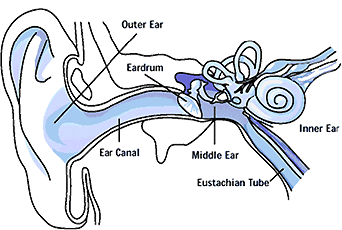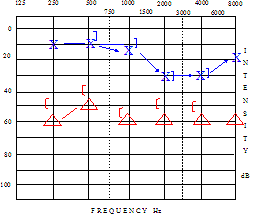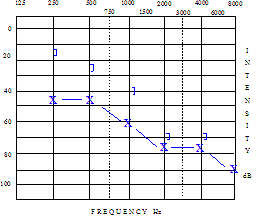Hearing & Hearing Loss
- How the ear works - parts of the ear
- Types of Hearing Loss
- Degree of Hearing Loss and Potential Effects
- Audiograms
How the ear works - parts of the ear

Outer ear
-
- Pinna - (also known as auricle) the outer portion of the ear that can be seen; helps with localization
- Ear canal - the passage between the pinna and the eardrum
- Middle ear
- Eardrum - or tympanic membrane. A three layer membrane that separates the outer and middle ear; vibrates to transfer sound to the middle ear bones
- Ossicle - three tiny bones of the middle ear; all three together are not larger than a dime
- Hammer - or maleus; first and largest of the three bones, connects the eardrum to the anvil; mechanically moves to transfer sound
- Anvil - or incus; second of the three bones; connects the hammer to the stirrup; mechanically moves to transfer sound
- Stirrup - or stapes; the third and smallest of the middle ear bones; connects the anvil to the oval window; mechanically moves to transfer sound to the cochlea
- Inner ear
- Cochlea - snail shaped part of the ear that contains the sensory organ of the hearing. Changes vibrations to nerve impulses
- 8th nerve - or auditory nerve; carries nerve impulses for the cochlea to the brain
- Semi-circular canals - three U-shaped canals of the vestibular / balance system; tells the body where the head is in space; responsible for the awareness of movement
Printer-friendly: Parts of the Ear (pdf)
Types of Hearing Loss
Conductive Hearing Loss

This type of loss is due to the inability of sound to pass through the outer and middle ear. The sound is prevented from passing through the middle ear due to a blockage such as wax, a foreign object in the ear canal, infection in the middle ear or malformation of the pinna, ear canal or middle ear bones. A conductive hearing loss is usually correctable through medical management such as surgery, medication, or removal of the obstruction.
Sensori-Neural Hearing Loss

This type of hearing loss occurs when there is damage to the cochlea (inner ear) or to the auditory nerve that goes to the brain. Sensorineural hearing loss cannot be medically or surgically corrected therefore this damage is permanent.
Mixed Hearing Loss

This is a combination of conductive and sensorineural hearing losses. There is a problem with the outer and middle ear and damage to the cochlea or auditory nerve.
Degree of Hearing Loss and Potential Effects
Every child is different. The possible effects of a hearing loss depends on degree of loss, early identification services, amplification, and parent involvement.
| DEGREE OF LOSS | POTENTIAL EFFECTS |
|---|---|
| MILD 20 - 40 dB: |
Without amplification, the child can hear most conversations up close and in quiet environments, but is likely to miss parts of words. The child may appear to be "hearing when she/he wants to." The child may experience some difficulty in communication and education settings. Language delay and speech errors may occur. Amplification and lip-reading may supplement understanding of what is said. Hearing aids and intervention should be encouraged. |
| MODERATE 41 - 55 dB: |
Without amplification, the child will have difficulty hearing spoken conversation. 50-100% of spoken conversations may be missed. Proper amplification and intervention should enable the child to hear and recognize most sounds. Speech and language development (e.g. - articulation, vocabulary development, voice quality) may be delayed without intervention. |
| MODERATELY-SEVERE 56 - 70 dB: |
Conversation must be very loud to be heard without amplification. Proper amplification will help the child to develop awareness of spoken language. Age of amplification, consistent use of hearing aids and intervention are important to help the child learn to use his/her hearing. The child is at risk for significant delays in spoken language speech understanding, language comprehension and voice quality. |
| SEVERE 71 - 90 dB: |
Without amplification, the child may hear loud voices and sounds close to the ear. If loss is from birth, spoken language and speech may not develop spontaneously, or could be severely delayed unless modifications and interventions are taken. With early and consistent use of hearing aids, many children will be able to detect sounds such as speech. Most children will use vision in addition to or in place of hearing. |
| PROFOUND 91 dB or greater |
Without amplification, the child will be more aware of sounds as vibrations. The child may rely on vision rather than hearing as the primary means for communication and learning. Speech and oral language will not develop spontaneously without modifications and intervention. Spoken language is significantly delayed, abnormal speech patterns may develop and voice quality is usually diminished. Amplification may or may not be useful in hearing spoken conversation. Residual hearing can benefit from amplification. Amplification may or may not be useful in hearing spoken conversation. The child is a potential candidate for a cochlear implant. Use of a signed language or a signed system may benefit language development. |
| UNILATERAL HEARING LOSS | Until recently, children with unilateral hearing loss did not have their hearing loss detected until they were in school. Now, with newborn hearing screening, unilateral hearing loss is detected during the first months of life. Children with unilateral hearing loss may be at risk for speech and language delays and/or educational difficulties. May have difficulty hearing faint or distant spoken conversations. Usually have difficulty knowing where sounds are coming from. May have difficulty understanding spoken conversations coming from the side of the head that has the hearing loss. |
Adapted from Hands & Voices CO Resource Guide
and Wisconsin's Interactive Notebook for Families
Printer-friendly: Degree of Hearing Loss (pdf)
Audiograms

The audiogram is a graph that represents how loud a sound at a specific pitch has to be for the child to hear the sound.
- Frequency - is pitch that is measured in Hertz (Hz). Usually frequencies of 250-8000 Hz are used in testing because this range represents where normal conversation speech occures, although the human ear can detect pitches from 20-20,000 Hz.
- Intensity - is loudness that is measured in decibels (dB) the audiogram usually reflects -10 to 110 dB with 0-20 dB being within normal limits.
- Configuration of hearing loss - is the shape of the hearing loss due to the amount of hearing loss at each frequency.
Decoding the Audiogram
Symbols
| Right Ear Symbol | Left Ear Symbol | |
|---|---|---|
| Air Conduction |  |
|
| Masked Air Conduction |  |
|
| Bone Conduction |  |
|
| Masked Bone Conduction |  |
 |
| Results suggest testing for at least the better of the two ears |
|
|---|---|
| Soundfield | S |
| Aided Soundfield | A |
Abbreviations
CNT - Could not test
DNT - Did not test
HA - Hearing aid
HAE - Hearing aid evaluation
NR - No response
SNHL - Sensorineural hearing loss
WNL - Within normal limits
AU - Both sides (ears)
AS - Left
AD - Right
RTC - Return to clinic
PRN - As needed
BC - Bone conduction
AC - Air conduction
PTA - Pure-tone average
UCL - Uncomfortable loudness level
MCL - Most comfortable loudness level
HFA - High frequency average
HL - Hearing level
SPL - Sound pressure level
SRT - Speech reception threshold
SAT - Speech awareness threshold
Configuration of Hearing Loss
Configuration refers to how the results of a hearing test look on an audiogram. For example, you can have hearing loss at one frequency or pitch, and not at another. You can also have a different degree of hearing loss at each frequency or pitch. Below are some of the most common configurations of hearing loss:
- Flat - equal across all frequencies
- Sloping - hearing gets poorer as you go up in pitch
- Reverse slope - hearing loss in the low frequencies, rising to better hearing at high frequencies
- Cookie bite - hearing loss in the middle frequencies, with better hearing at high and low frequencies
- Asymmetrical - hearing loss greater in one ear than in the other



